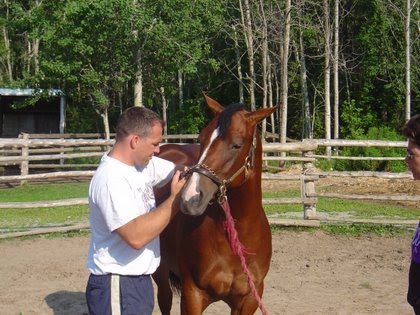 Chiropractic care is a holistic approach to many of the health and performance problems of the horse. Chiropractic does not replace traditional veterinary medicine and surgery, but provides an alternative method of care. Chiropractic adjustments have proven to be invaluable in detecting and treating gait abnormalities and other performance-robbing problems in the athletic horse. It has also been shown to alleviate pain in the back and neck of the horse. Some nerve damage, such as pressure on the sciatic nerve, has responded well to chiropractic adjustments.
Chiropractic care is a holistic approach to many of the health and performance problems of the horse. Chiropractic does not replace traditional veterinary medicine and surgery, but provides an alternative method of care. Chiropractic adjustments have proven to be invaluable in detecting and treating gait abnormalities and other performance-robbing problems in the athletic horse. It has also been shown to alleviate pain in the back and neck of the horse. Some nerve damage, such as pressure on the sciatic nerve, has responded well to chiropractic adjustments.
How Do I know if my Horse Needs Chiropractic Care?
-
Loss or decrease in level of performance.
- Problems or difficulty executing desired movements.
-
Behavioral changes (i.e. refusals, cinchy, bucking).
-
Short striding.
-
Diagnosed conditions, such as degenerative arthritis.
-
Muscle imbalance, spasms, or atrophy.
-
Gait problems, such as cross-canter, loss of collection, refusal to pick-up lead.
-
Injuries resulting from falls, training, or other activities.
-
Stressful situations, such as conformation of the horse, various riding and training equipment, performance level and ability of the rider, shoeing.
There are numerous, common stressful or traumatic situations, such as the birth process, conformation of the horse, training and riding equipment, ability of the rider, shoeing trailers, or direct trauma, that can cause abnormal or restricted movement to occur in the spine. This change in proper movement of the spine is what chiropractors call a “subluxation”. When a subluxation occurs, the horse’s spine loses it’s normal flexibility. This results in stiffness which further leads to resistance and decreased performance. The most common symptom associated with spinal subluxations is pain, which can manifest changes itself in a variety of ways. Horses in pain will show compensatory changes in posture and gait. These changes can cause stress in other joints and muscles.
Symptoms such as lameness, stiffness, lack of impulsion or power, difficulty in obtaining or maintaining collection, poor attitude, gait abnormalities, being cold-backed or cinchy, or the presence of muscle atrophy are commonly associated with spinal misalignments.
Subluxations may also cause changes in muscle coordination and flexibility that affects the performance ability of the horse. These symptoms may be lack of coordination in gaits, unusual, perhaps indefinable gait abnormalities which vary from limb to limb and change depending on gait, stiffness in lateral movements of neck or back, rope walking, shortened stride in one or two limbs, inability to engage rear quarters, difficulty flexing at the poll, or on line or pulling on one rein.
Common complaints from horse owners include resistance or stiffness when moving to one direction, irritability, decreased performance, and sensitivity to touch, such as when being brushed.
To answer this, it is important to remember that the chiropractor is not adjusting the entire horse, but rather a specific joint in the spine.
Initially, a complete chiropractic examination is performed. This typically includes a case history, including any previous veterinary work performed, posture analysis, gait analysis, static and motion palpation of the spine and its joints, muscle palpation, and checking for any changes in temperature over the spine.
Once the initial examination has been completed, the animal chiropractor will perform an adjustment on the area of the spine affected, so as to return the joints to normal motion, and to alleviate any muscle spasms and pain. A chiropractic adjustment is a very specific, high velocity, low force, controlled thrust by a hand, which is directed in a specific direction on a specific joint.
Several factors determine the number and frequency of adjustments required to correct a problem. The horse’s age and physical condition are important; young healthy horses will generally require fewer adjustments than older horses or those with serious health problems. The severity of the problem is another major factor; if permanent damage has occurred, a return to full flexibility may not be possible, and multiple adjustments may be necessary to achieve the most flexibility possible. The length of time though problem has been present is also a factor; longstanding, or chronic problems frequently require more adjustments to correct than do acute problems.